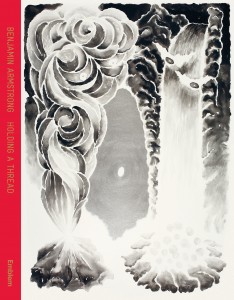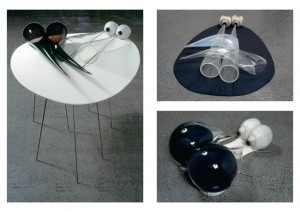Din Heagney takes a tour through the rich pages of Holding A Thread, a new book on the work of Benjamin Armstrong…
I remember the first time I saw a Benjamin Armstrong work. It was like something from a half-remembered nightmare, a science lab model crossed with a surrealist horror movie prop. It caused a feeling of body dissociation, like looking at a pair of eyes extracted from their sockets and turned inside out in order to look back at themselves, only to find themselves defunct. Juliana Engberg describes Armstrong’s work as ‘the trauma of looking’ and I remember a feeling of itchy eyes after first seeing his work, but his imagery stayed with me in a funny and slightly disturbing way.
Holding a Thread is the first book from new Sydney art publisher Emblem Books, and is a retrospective collection of Armstrong’s work over the last ten years. With only an introductory essay by Engberg and conversation transcript between the artist and Charlotte Day, the book is refreshingly light on text and made up mostly of colour reproductions. It’s also hardcover which is just plain sexy.
I have to say I was pleasantly surprised when I pulled it from its packaging, breathing a long sigh of relief that an Australian publisher was making real artist books. I’m not talking about academic texts and catalogues disguised as artist books, nor those whopping great tomes that crush you under their weight. I’m not talking about the kind of artist books that have been ravaged apart and badly reassembled by a frustrated graphic designer, or the type that consist of reams of postulation and a couple of colour plates thrown in, almost as an afterthought. No, I’m talking about the kind of artist books that focus primarily on bringing an artist’s work to life in your hands. The type of publishing I have been longing for: one that combines concise writing with simple design and a big dose of love. And here it is. But enough of the gratitude…
The introduction of Holding a Thread is set in a large typeface with the sort of generous spacing that gives you the sense you are reading a children’s book until you reach words in the first paragraph like ‘ontological’, which made me wonder how I would best describe its meaning to a child. I remain stumped. In any case, Engberg’s essay is another of her typical goldmines of thinking around an artist’s work, even if she does have something of a fetish for the phenomenological body, perhaps even psychophysics. Reading her introductory comments about the eye as ‘multi-ocular orifice’ took me back some years ago when I worked at ACCA as a gallery floor bitch. One night at an opening we had the longest conversation I ever had with her, in fact it was the only conversation I ever remember having with the boss. I commented that a closed eye looks remarkably like a sphincter. We then talked about the eye as a digestive organ, taking shit in, sending it to the mind where it is anal-ysed and refined. We didn’t get much further than that, but it seems apt now that I’m looking at this oeuvre of Ben Armstrong.
The visual section, made up of a hundred full colour reproductions is set out into three parts: Drawings, Sculptures and Prints. By far my favourite works of Armstrong’s are his drawings. I find them entirely evocative, delicate tributes to the power inherent within natural structures. His steaming waterfalls and exploding volcanoes, rendered in watercolour, give shape and weight in the lead up to his more heavily handed sculptures further on. There is almost a warning in some of his images, these conscious alien landscapes, sinister underwater squids that stare malevolently up at you and the final blind witness, which Engberg compares to Oedipus. Visually, this comparison seems appropriate but I’m not convinced that Armstrong’s image is of someone whose eyes are removed from the horror of seeing the truth.
The second section features Armstrong’s numerous sculptures printed on a satin stock, which works well in the book, separating the drawing and prints sections texturally and providing the necessary sheen to give impact to the reproductions of his waxy, glass sculptures. These works seem much more loaded psychologically, they capture the representative field of vision. Ovoid concoctions of rods, cones and disembodied ganglion nerves, these anatomical forms dissect and elaborate on the physical process of seeing.
The final section of prints is possibly the weakest of all the work in the book. Armstrong’s line work lacks the depth and subtlety of his drawings, or the force and physicality of his sculptures, but nonetheless capture some of the recurring forms within his practice. This last section also feels more researchy in its presentation and, unlike the endsheets featuring a photograph of the prints pinned up across the artist’s studio wall, they remain exploratory and a little unresolved. But perhaps that’s the point, Armstrong is only 35 years old and clearly this impressive volume marks the early development of a fascinating artist.
Armstrong comments in the book’s final section, a conversation transcript with Charlotte Day: “It was intriguing to learn that one of the first tiny organisms on earth evolved to detect light and dark; meaning the simplest form of life was an eye of sorts that was sensitive to light. Our eyes are basically this same organism further down the evolutionary track.“ Despite the truly gorgeous production values at work here by Emblem, Armstrong’s work still make my eyes itch, but I think that can only be a good thing – it shows they’re working hard to comprehend what’s being fed to them. And that makes me wonder: perhaps evolution itches.
BENJAMIN ARMSTRONG: HOLDING A THREAD
Essay by Juliana Engberg Conversation with Charlotte Day and Benjamin Armstrong
Hardcover, 15.5 x 22 cm, 140 pages, over 100 full-colour images
Retail price $44
www.emblembooks.com



